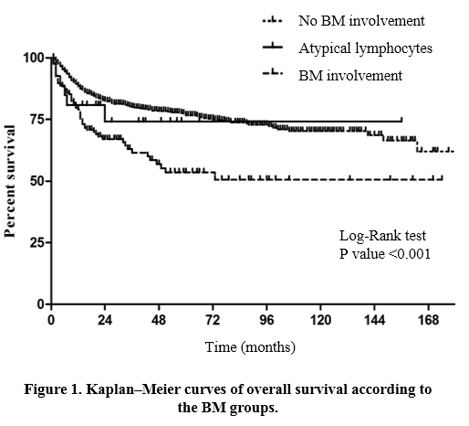
Contributions
Abstract: PB2067
Type: Publication Only
Background
Bone marrow (BM) biopsy with or without aspiration is usually included in the staging workup for patients with non-Hodgkin’s lymphoma (NHL). According to the National Comprehensive Cancer Network guidelines, BM biopsy is mandatory for lymphoma, but aspiration is optional. Moreover, the role of BM aspiration is controversial. Other studies have shown that BM aspiration morphologically or flow cytometry is often inconsistent with biopsy and is less likely to detect lymphoma than biopsy. There are no clear guidelines regarding results that are positive in BM aspiration and negative in biopsy.
Aims
The aim of this study was to establish guidelines through a comparison of the overall survival (OS) of patients with NHL using morphological method.
Methods
We performed a retrospective analysis of BM involvement in patients with newly diagnosed NHL in the Korea University Hospital from January 1991 to December 2016. OS was compared according to the BM groups, which were divided into three groups: the group without BM involvement in both BM aspiration and biopsy, the group with atypical lymphocytes only in BM aspiration, and the group with BM involvement in biopsy regardless of BM aspiration results. Atypical lymphocytes were identified as positive in BM aspiration if they displayed cleaved nuclei, vacuolation, and granulation including lymphoid aggregates, leukemic presentation of mature B-cell neoplasm, and lymphoma associated hemophagocytic lymphohistiocytosis. Reactive changes, or relative lymphocytosis were excluded. OS was assessed using the Kaplan-Meier method, and the log-rank test was used for comparison between the groups. Multivariate analysis were performed using a Cox proportional hazards model.
Results
In total, the data of 1,773 patients, of which 391 patients had indolent NHL and 1,382 patients had aggressive NHL, were reviewed. Of the 1,773 patients, 1,148 (64.7%) yielded negative results on both BM aspiration and biopsy, 30 (1.7%) yielded positive results with atypical lymphocytes only in BM aspiration, and 190 (10.7%) yielded positive results on biopsy. Remaining 405 patients were excluded owing to inadequate results in BM aspiration and/or biopsy. Median follow-up duration was 37.62 months (range, 0–288).

Conclusion
This study suggests that the detection of morphologically atypical lymphocytes only in BM aspiration, but not in biopsy, is not significant in predicting the OS of patients with NHL. Therefore, even if atypical lymphocytes are detected during BM aspiration in patients with NHL, it may not be sufficient to judge the BM involvement and predict the OS of these patients.
Session topic: 18. Non-Hodgkin & Hodgkin lymphoma - Biology
Keyword(s): Survival, Non-Hodgkin's lymphoma, Bone marrow involvement
Abstract: PB2067
Type: Publication Only
Background
Bone marrow (BM) biopsy with or without aspiration is usually included in the staging workup for patients with non-Hodgkin’s lymphoma (NHL). According to the National Comprehensive Cancer Network guidelines, BM biopsy is mandatory for lymphoma, but aspiration is optional. Moreover, the role of BM aspiration is controversial. Other studies have shown that BM aspiration morphologically or flow cytometry is often inconsistent with biopsy and is less likely to detect lymphoma than biopsy. There are no clear guidelines regarding results that are positive in BM aspiration and negative in biopsy.
Aims
The aim of this study was to establish guidelines through a comparison of the overall survival (OS) of patients with NHL using morphological method.
Methods
We performed a retrospective analysis of BM involvement in patients with newly diagnosed NHL in the Korea University Hospital from January 1991 to December 2016. OS was compared according to the BM groups, which were divided into three groups: the group without BM involvement in both BM aspiration and biopsy, the group with atypical lymphocytes only in BM aspiration, and the group with BM involvement in biopsy regardless of BM aspiration results. Atypical lymphocytes were identified as positive in BM aspiration if they displayed cleaved nuclei, vacuolation, and granulation including lymphoid aggregates, leukemic presentation of mature B-cell neoplasm, and lymphoma associated hemophagocytic lymphohistiocytosis. Reactive changes, or relative lymphocytosis were excluded. OS was assessed using the Kaplan-Meier method, and the log-rank test was used for comparison between the groups. Multivariate analysis were performed using a Cox proportional hazards model.
Results
In total, the data of 1,773 patients, of which 391 patients had indolent NHL and 1,382 patients had aggressive NHL, were reviewed. Of the 1,773 patients, 1,148 (64.7%) yielded negative results on both BM aspiration and biopsy, 30 (1.7%) yielded positive results with atypical lymphocytes only in BM aspiration, and 190 (10.7%) yielded positive results on biopsy. Remaining 405 patients were excluded owing to inadequate results in BM aspiration and/or biopsy. Median follow-up duration was 37.62 months (range, 0–288).

Conclusion
This study suggests that the detection of morphologically atypical lymphocytes only in BM aspiration, but not in biopsy, is not significant in predicting the OS of patients with NHL. Therefore, even if atypical lymphocytes are detected during BM aspiration in patients with NHL, it may not be sufficient to judge the BM involvement and predict the OS of these patients.
Session topic: 18. Non-Hodgkin & Hodgkin lymphoma - Biology
Keyword(s): Survival, Non-Hodgkin's lymphoma, Bone marrow involvement


